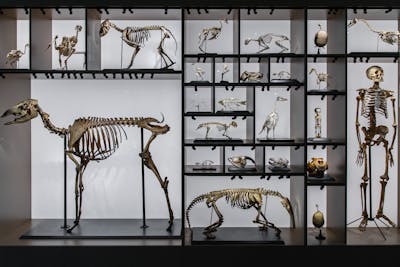
The theory of evolution by natural selection is supported by a vast amount of evidence from various scientific disciplines. Here are some of the very strong pieces of evidence:
Fossil Record:
- Transitional Fossils: These fossils bridge the gap between different species, showing gradual changes over time. For example, fossils like Tiktaalik show a creature with fish-like features but also limbs and a neck, hinting at the evolution of land animals from aquatic ancestors.
- Dating Techniques: Geologists can date fossils and rock formations, allowing us to create a timeline of life on Earth. This timeline aligns beautifully with the predicted order of evolution based on anatomical similarities.
Comparative Anatomy:
- Homologous Structures: These are similar body parts in different species that share a common ancestor but may have adapted for different functions. For example, the wings of a bird, the flippers of a whale, and the arms of a human all share a similar underlying bone structure, suggesting a common evolutionary origin.
- Vestigial Structures: These are remnants of structures that were once functional in an ancestor but have become vestigial or reduced in size in a descendant. For example, humans have a tailbone, a remnant of a tail that was useful for our ancestors but no longer serves a major purpose in our bodies.
Comparative Embryology:
- Early Development Similarities: Embryos of various species, despite their adult differences, often share similar developmental stages in their early development. This suggests a deep evolutionary relationship. For example, fish, frog, bird, and human embryos all have a similar basic body plan at early stages.
Genetics:
- DNA Similarities: DNA analysis reveals the degree of genetic relatedness between species. Closely related species share a higher percentage of their DNA, supporting the idea of common ancestry and evolutionary divergence.
- Genetic Mutations: Mutations in genes can lead to changes in traits, which can be beneficial or detrimental. Natural selection then favors beneficial mutations, leading to the gradual adaptation of a species over time.
Biogeography:
- Continental Drift: The continents were once a single landmass (Pangea) that has since drifted apart. This explains why similar fossils are found on continents that are now separated by vast oceans, suggesting they were once part of the same habitat.
- Island Endemism: Islands often have unique species that are not found elsewhere. This is because these species evolved from ancestral forms that arrived on the island and adapted to the specific island environment.
Direct Observation:
- Antibiotic Resistance: Bacteria can evolve resistance to antibiotics through natural selection. This rapid evolution can be observed in real-time, providing a compelling example of how evolution works.
- Selective Breeding: Artificial selection, practiced for generations with animals and plants, demonstrates how selective pressures can lead to rapid changes in traits. This process mirrors natural selection in the wild.
The evidence for evolution is overwhelming and comes from multiple scientific fields. While some details are still being debated, the core concept of evolution by natural selection is a well-established theory in biology.
